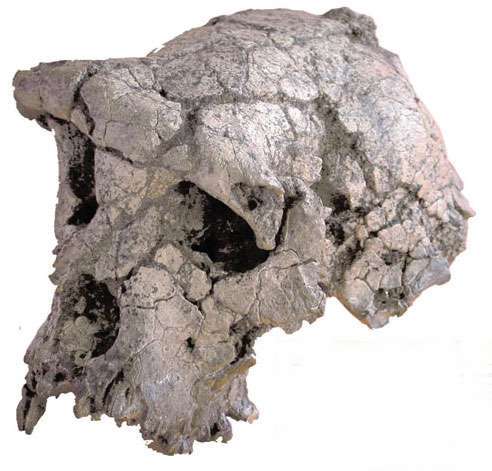
Hominid Species Time Line
Page 4
I. The Earliest Hominids
Sahelanthropus tchadensis — “Toumai”
Sahelanthropus tchadensis (“Sahel man from Chad”) is also nicknamed Toumai, “hope of life” in the Goran language. This is a common name given to babies born just before the dry season whose chances of survival are not high.

TM 266-01-60-1 — Sahelanthropus tchadensis
Discovered in 2001 by a joint French-Chadian expedition in Chad led by Michel Brunet, this find was a surprise in many ways. This is one of the few early hominids found in central Africa rather than in the eastern and southern portions of the continent, and it is by far the oldest. Previously, it was thought that the Rift Valley of east Africa was a geographical boundary line between apes, who developed in the forests west of the line, and hominids, who were thought to have emerged in the drier eastern portion of Africa.
Toumai is approximately a million years older than the next oldest known hominid, dating to approximately seven million years in age. It should be noted that dating of remains in this part of Africa cannot be obtained by radiometric means, and instead is based on comparison of assemblages of fossils in east Africa, where absolute dates have been established. The comparisons provide reasonably certain dates.
This species was originally represented only by partial and fragmentary remains, including a single, mostly complete skull. Other fragmentary remains of this species, mostly teeth and jaws, have been found since, representing at least six and perhaps as many as nine individuals.
Part of the excitement about this find is that, given its age, this creature must have lived near the time of the presumed divergence of hominid from chimpanzee lines. In fact, estimates based on the “molecular clock” placed the divergence at somewhere between five and seven million years ago [the earliest estimates were 3 million years ago). The discovery of Orrorin tugenensis (see below) in the year 2000 had already pushed estimates back toward the earlier date.
The “Toumai” skull has features that one would expect to see at that divergence point. This creature was about the size of a chimp and has roughly the same brain capacity (@ 360-370 cc). Other features, such as its prominent brow bridges, however, resemble early human characteristics. Its front teeth are small and the canines are relatively undeveloped; the thickness of its dental enamel is mid-way between chimps and later australopithecines. Its facial angles and skull shape are significantly different from modern chimps.
The chief issue is determining where S. tachadensis stands in relation to the “great divergence” of the chimpanzee and hominid lines. Is it from before or after? With only a single, partial skull and a few other bones in evidence, the argument focuses on the position of the foramen magnum, the hole where the spinal cord attaches to the brain. Unfortunately, the skull has been deformed and distorted during its long fossilization, and it proved difficult to reconstruct this area with confidence. While some investigators claim that the species has many characteristics in common with other hominids and therefore was likely to be bi-pedal, others note that the foramen magnum is positioned toward the back of the skull, as in apes.
One scholar, Briggitte Senut, the discoverer of Orrorin tugenensis, has suggested that this creature lived before the divergence and is not a hominid at all. In contrast, an April 2005 article by Bernard Wood in Nature presents a computer-simulated “virtual reconstruction of the skull that allegedly corrects the distortions and places the foramen magnum under the skull. On the basis of that reconstruction, the article claims that ”S. tchadensis might have been an upright biped,” and “that bipedalism was present in the earliest known hominids, and probably arose soon after the divergence of the chimpanzee and human lineages.”
Without more evidence — for example, femur and pelvic bones, or a complete and undistorted skull — the issue of S. tachadensis‘s mode of locomotion is unlikely to be resolved satisfactorily. If Toumai is a hominid, it is the earliest discovered so far. Unfortunately, no ancestral species clearly in the chimp line have as yet been found, so we have no chimp ancestor to compare it to.
References:
Bernard Wood, “Palaeoanthropology: Hominid revelations from Chad,” Nature 418 (11 July 2002), 133-135.
Sahelanthropus tchadensis on TalkOrigins.org